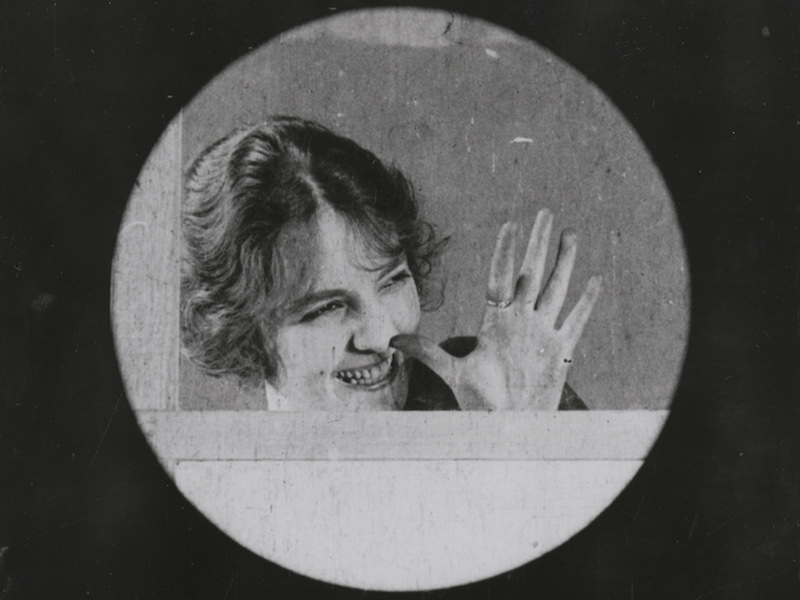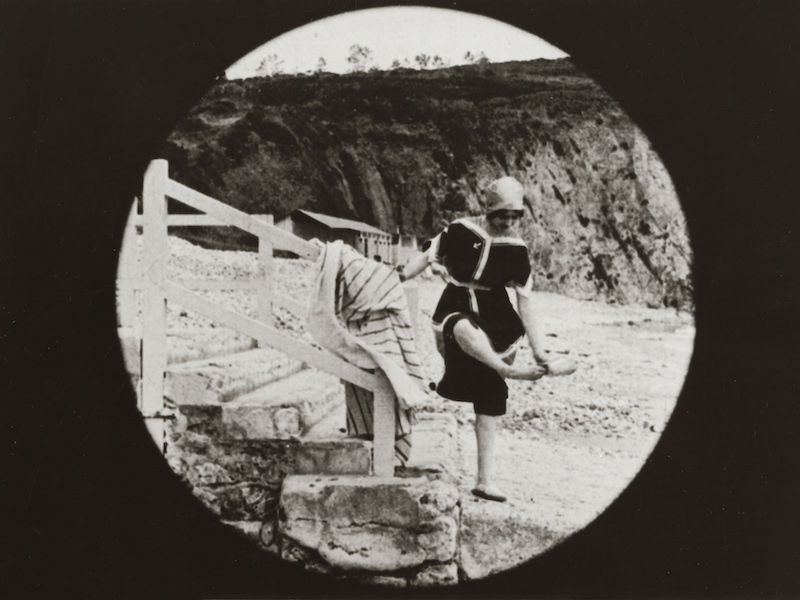Suzanne Grandais – Prog. 1
LE CHRYSANTHÈME ROUGE (Il crisantemo rosso / Love’s Floral Tribute) (FR 1912)
regia/dir: Léonce Perret. photog: ?. cast: Suzanne Grandais (Miss Suzie), Léonce Perret, Émile Keppens, André Luguet. prod: Gaumont. uscita/rel: 02.1912. copia/copy: DCP, 13′ (da/from 35mm, b&w, pochoir/stencil-colour); did./titles: FRA. fonte/source: Gaumont Pathé Archives, Saint-Ouen, Paris.
One of the great cinema collaborations began in late 1911 when Léonce Perret first directed Suzanne Grandais in Le Chrysanthème rouge. For many of us, just as for Didier Blonde, our first encounter with her is electric: seated in her artistic salon, casually smoking a cigarette, she has a warm mastery of the space as well as of the friends she’s gathered there. Two men remain behind, rivals for her affection. To appease them she says that whoever brings her a bouquet of her favorite flowers will win her heart, but watching this supremely confident women, giddy in her enjoyment of life, we know that she’s playing a game, as she’s far too clever to bestow her heart in such a casual manner.
Dominique Païni, in the 2003 AFRHC Perret monograph edited by Bernard Bastide and Jean A. Gili, describes the director as the last of the Symbolists, situating Grandais’ character in a long line of femme fatales and discussing the now-forgotten language of flowers and its usage in this film. Those elements are certainly there, yet Grandais is flirtatious, not cruel, and humor forms a major part of the narrative until the unexpected ending, when one of her suitors deliberately cuts himself and bleeds on the white chrysanthemum he’s brought, since she’s declared that only red ones will make her happy. The resulting image, hand-colored sanguine, is a disturbing jolt in the otherwise light-hearted story, but the mood lifts again after she bandages his wound and smilingly tells her other suitor (Perret himself) that she’s giving her heart to his rival. Will she, though? As she stands there in her Arts and Crafts gown, the image of a modern woman embracing a very old-fashioned-looking gentleman, we suspect she’s simply biding her time, waiting for a genuine love who won’t need to make any gruesome self-sacrifices. She’s not Rudyard Kipling’s vampire – simply a self-assured woman re-writing social norms on her own terms.
Jay Weissberg
LE HOMARD (GB: A Lucky Lobster; US: Lobsters, All Styles) (FR 1913)
regia/dir: Léonce Perret. photog: Georges Specht. cast: Léonce Perret (Léonce), Suzanne Grandais (Suzanne), Valentine Petit (bagnante/a bather). prod: Gaumont. uscita/rel: 01.1913. copia/copy: DCP, 14’20”; did./titles: FRA. fonte/source: Gaumont Pathé Archives, Saint-Ouen, Paris.
LE HOMARD (De Kreeft) (GB: A Lucky Lobster; US: Lobsters, All Styles) (FR 1913) (estratto/extract)
regia/dir: Léonce Perret. photog: Georges Specht. cast: Léonce Perret (Léonce), Suzanne Grandais (Suzanne), Valentine Petit (bagnante/a bather). prod: Gaumont. uscita/rel: 01.1913. copia/copy: DCP, c.3′ (da/from 35mm, pochoir/stencil-colour); senza did./no titles: FRA. fonte/source: EYE Filmmuseum, Amsterdam.
Not quite two years after Grandais’ death, a writer in Ciné-Journal (22.04.1922), still feeling her loss, says the actress will always be remembered for Le Homard. The film was the first in Gaumont’s new series “Léonce”, based on the director-actor’s cinema persona, in which he was frequently paired with Grandais or his other muses, curiously also named Suzanne (Petit and Le Bret), all playing a character named Poupette. In the above-mentioned 2003 AFRHC Perret monograph, Laurent Le Forestier claims that Léonce’s wife in Le Homard is also named Poupette, though the Gaumont print, containing modern intertitles, calls her Suzanne.
While vacationing in Dinard, Suzanne has a hankering for lobster, but Léonce is too cheap to offer what the lobster catchers want. To appease his sulking wife, he pays a fisherman to make it look as if he’s braved a storm and caught the crustaceans himself, when in reality he’s been enjoying a comic film at the cinema, the latter action seen in a clever triple-screen in which Suzanne, fearful for her husband’s safety, prays on the left-hand side while waves crash against rocks in the center and Léonce roars with laughter in the theatre on the right (movie posters outside advertise Zigoto et le château mystérieux; La Cassette de l’émigrée, Perret’s own Le Lien, and one other difficult to make out). His ruse is revealed when Suzanne encounters the fisherman, leading to a fit of pique that would nicely fit in with this year’s “Nasty Women” section. Still annoyed at her husband, Suzanne goes bathing, but while looking at her through binoculars (realized in an edited sequence of iris shots), Léonce sees she’s wincing in pain; coming to the rescue, he removes a large lobster from her backside.
By now Grandais’ character was well-established, embodying a loving yet strong-minded woman who won’t be made anyone’s fool, though in the end she’s game for a joke even when it’s on her. While the Gaumont print is the longest known, EYE Filmmuseum has a shorter stencil-colored print too lovely not to screen, which is why we’re also showing the final few minutes of the color version.
Jay Weissberg
LES ÉPINGLES (Gli spilloni da cappello / For Two Pins) (FR 1913)
regia/dir: Léonce Perret. photog: Georges Specht. cast: Léonce Perret (Léonce), Suzanne Grandais, Émile Keppens (dottore/the doctor). prod: Gaumont. uscita/rel: 02.1913. copia/copy: 35mm, 268 m. (orig. 279 m.?), 14’20” (16 fps), b&w, col. (imbibito/tinted); did./titles: ENG. fonte/source: EYE Filmmuseum, Amsterdam.
A feature – hardly unique – of the “Léonce” series was the way the characters acknowledge the audience, such as the charming moment in Les Épingles when Léonce and Suzanne are about to kiss but he looks at the camera and shyly shields their embrace from viewers with a desk blotter. The thin plot is ostensibly about hatpins, but is designed as another opportunity for husband and wife (called Mr. and Mrs. Doodledum in the American release) to play good-natured tricks on each other. When Suzanne refuses to wear a hatpin shield despite a new law requiring that the tips be covered, Léonce pretends to be injured by the sharp point. She discovers he’s faking it when she spies him laughing with the doctor, prompting her own phony injury, until that too is revealed and the couple reunite behind closed doors.
Gaumont’s English-language advertising characterized the film as “A delightful comedy, funny yet refined,” which is a perfectly accurate summation. In his silent comedy programming for the Museum of Modern Art, Steve Massa has pointed out the influence of the “Léonce” series on the Vitagraph comedies of Mr. and Mrs. Sidney Drew, a parallel which feels very pronounced here. Once again Suzanne gets the last laugh, making clear that she is nothing if not an equal partner in both the relationship and the pranks.
Jay Weissberg
UN NUAGE PASSE (Un Nuage) (Donkere Wolkjes) (A Passing Cloud) (FR 1913)
regia/dir: Léonce Perret. photog: Georges Specht. cast: Léonce Perret (Léonce), Suzanne Grandais (Suzette/Suzanne). prod: Gaumont. uscita/rel: 01.1913. copia/copy: 35mm, 215 m. (orig. 240 m.?), 10’34” (18 fps), col. (imbibito/tinted); did./titles: NLD. fonte/source: EYE Filmmuseum, Amsterdam.
The passing cloud of Un Nuage passe is both a metaphorical one that temporarily disrupts household harmony, and an actual cloud in the puffs of cigarette smoke causing the short-lived contretemps between newlyweds. If Léonce can smoke at breakfast, so can Suzanne, but he’s not happy about her lighting up, and their mutual stubbornness leads to separate bedrooms. Gesturing to the audience so we understand how much she needs her husband’s embrace, Suzanne tries for a reconciliation, but he’s fast asleep in the other room. Her screams when a couple of mice get into her bed bring him running, and at the end Cupid himself appears, ensuring the lovebirds are back in each other’s arms.
Jay Weissberg
LA DEMOISELLE DES P.T.T. (De Juffrouw van de Post) (US: Shooing the Wooer) (FR 1913)
regia/dir: ?. photog: ?. cast: Suzanne Grandais (Suzanne), Léon Lorin (Oscar Sanzatoux), Sarah Duhamel (Rosalie) (?). prod: Gaumont. uscita/rel: 03.1913; US rel. 07.08.1913. copia/copy: 35mm, 201 m., 9’52” (18 fps); did./titles: NLD. fonte/source: EYE Filmmuseum, Amsterdam.
When La Demoiselle des P.T.T. screened at the Gaumont-Palace in March 1913, the program described Suzanne as “a kind little miss whom the State allows to work with post, telegraph, and telephones for a ridiculously small monthly wage […] responding to a cranky public during ungodly hours.” Spectators might have confused the luxury cinema’s program for a trade union pamphlet. Just four years earlier, female telegraph and postal workers had gained the sympathy of the French public when the politician Julien Simyan called them saloperies and sales poupées (whores and filthy dolls). His sexist insults triggered the first general strike of postal and telegraph workers, in which workers cut telegraph lines, making communication impossible in much of the country.
La Demoiselle des P.T.T. harnesses public interest in these women at the frontlines of modern communications. Grandais embodies a little of the anarchist spirit in a role very different from the bourgeois women she previously played at Gaumont. Here she steps confidently into the role of the modern working girl, a role she would take up later at Eclipse with Louis Mercanton and René Hervil films such as Midinettes (1917) and Son aventure (1919).
The film is part of the “Oscar” comedy series (1913-1914) starring Léon Lorin as Oscar Sanzatoux, an old bourgeois gentleman with trademark monocle, top hat, and cane. The director is unknown. The “Oscar” films are sometimes attributed to Louis Feuillade, other times to Léonce Perret, Raoul d’Auchy, or to Lorin himself. In La Demoiselle des P.T.T. Oscar makes advances on Suzanne, who in her response shows her mastery of urban space and modern communication technologies. Oscar calls Suzanne on the telephone, and in a three-panel split-screen shot, with telegraph wires in the center panel (we’ll see another three-way split screen in Le Homard), Suzanne rebuffs his advances. Oscar persists, sending himself a letter to be collected from Suzanne in person. She intercepts the letter and writes her own note to Oscar, which he furiously reads under the laughing eyes of Suzanne and her fellow workers. Although the film is missing a letter insert, De Bioscoop-Courant describes the letter as containing the following lines from La Fontaine’s tale “The Ass and the Lapdog”: “We should never force the talent we receiv’d from nature, for then everything we do will be ungraceful. A lumpish creature, tho’ he take the utmost pains, will never catch a graceful air!”
Annie Fee












